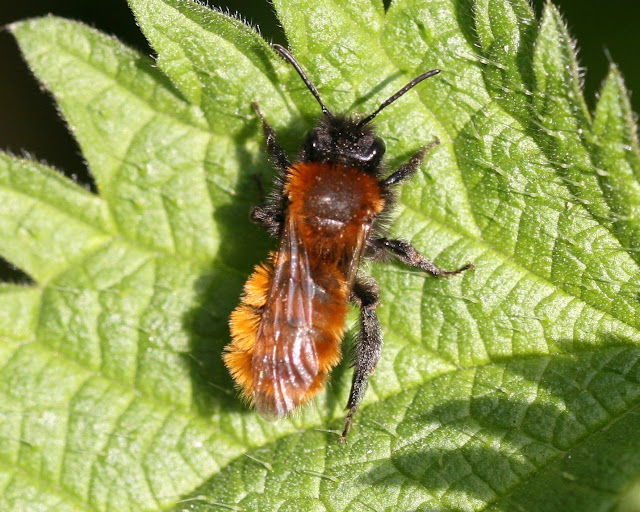The patch is quite rewarding now with summer birds appearing, and insects increasingly part of the fauna. One particular area got my attention today.
It's a common enough sight - a patch of bare earth with a mass of holes and piles of finely tilled earth. I've seen this for the last couple of years and decided to have a good look.
In the morning it was a mass of small bees. I went back in the afternoon with my camera, and saw other things. Firstly, the bees. Here's one forlornly trying to dig a hole
It's quite a tiny bee, and clearly a mining bee, so I think I'm on firmer ground than the bee when I suggest this is a mini-miner. I'm happy to say its probably Common Mining Bee, given that they are, well, common.
In the afternoon there were other different bees. These were even smaller, with bright red abdomens that were only clearly visible in flight. These look like Nomad bees. These are kleptoparasites, and I'm going for Little Nomad Bee, as it is common, and a parasite of Common Mining Bee. Here's a photo of one in flight. Pretty amazing photo too, if I'm honest. It's out of focus, but you try snapping a photo of a tiny bee in flight!
and here's a nomad bee doing what nomad bees do - disappearing down a mining bee nest hole. What goes on down there is, according to wikipedia, as follows "The female cuckoo bee will lay her eggs in the host’s nest and leave. Nomada are known to leave specialized egg structures in the host cell. These eggs are placed into the innermost wall of the host cell, yet there is a lot of diversity among Nomadinae regarding the manner of egg insertion. Some species are known to bury the egg at right angles into the cell wall, while some only partially insert the egg. Nomada may sometimes leave multiple eggs into one host cell, a frequent trait of kleptoparasitic bees. Using their unique mandibles, the parasite larvae kill the host offspring and the conspecific larvae until only one is alive. This larva then steals the host’s allocation of pollen or nectar. "
There were other creatures too - spiders, ants, which I'm thinking are in some way connected with this. It's a pretty amazing thing to think of the lifeforms gathering round this patch of bare earth, and the depths at which life is happening. A veritable insect city, underneath our feet.
Finally a Digger Wasp. We know about these, having had a colony of Ornate Digger Wasps on the patch a couple of years ago. More deep nesting insects, more gruesome life histories. It's all going on.













